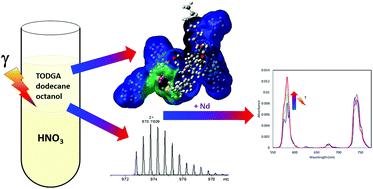当前位置:
X-MOL 学术
›
New J. Chem.
›
论文详情
Our official English website, www.x-mol.net, welcomes your
feedback! (Note: you will need to create a separate account there.)
An experimental and computational look at the radiolytic degradation of TODGA and the effect on metal complexation
New Journal of Chemistry ( IF 2.7 ) Pub Date : 2021-06-21 , DOI: 10.1039/d1nj01143j Ashleigh Kimberlin 1, 2, 3, 4, 5 , Dominique Guillaumont 1, 2, 3, 4, 5 , Sylvie Arpigny 1, 2, 3, 4, 5 , Béatrice Camès 1, 2, 3, 4, 5 , Philippe Guilbaud 1, 2, 3, 4, 5 , Georges Saint-Louis 1, 2, 3, 4, 5 , Hitos Galán 6, 7, 8, 9 , Laurence Berthon 1, 2, 3, 4, 5
New Journal of Chemistry ( IF 2.7 ) Pub Date : 2021-06-21 , DOI: 10.1039/d1nj01143j Ashleigh Kimberlin 1, 2, 3, 4, 5 , Dominique Guillaumont 1, 2, 3, 4, 5 , Sylvie Arpigny 1, 2, 3, 4, 5 , Béatrice Camès 1, 2, 3, 4, 5 , Philippe Guilbaud 1, 2, 3, 4, 5 , Georges Saint-Louis 1, 2, 3, 4, 5 , Hitos Galán 6, 7, 8, 9 , Laurence Berthon 1, 2, 3, 4, 5
Affiliation

|
Diglycolamide extractants, and in particular N,N,N′,N′-tetraoctyl diglycolamide (TODGA), are currently under investigation for use in nuclear fuel reprocessing by liquid–liquid separations. Several processes, such as ARTIST, i-Sanex, and EURO-GANEX processes, have been developed around the TODGA extractant. The solvent typically combines TODGA with a modifier in an alkane diluent. Due to the high radiation produced by the actinides and fission products present in the fuel, radiolytic degradation can greatly alter the chemistry of these solutions. The radiolysis and hydrolysis of the diglycolamide-based extractant was investigated. The effects of the presence of 1-octanol as phase modifier in organic phase and nitric acid concentration in aqueous phase were investigated. Nitric acid provides a slight protective effect, whereas the presence of 1-octanol seems to have a slight sensitizing effect. Fukui function calculations were done to supplement the experimental data and give an improved understanding of the behaviour of TODGA organic solutions after radiolysis. An increase in nitric acid concentration protects TODGA from radiolysis as nitrate absorbs the radicals. The slight sensitizing effect of 1-octanol is due to a combination of several competitive effects: a protective effect from TODGA–octanol adducts and a sensitizing effect from an increase in the water concentration in the organic phase, which produces ˙OH radicals. Lanthanide extraction was performed with irradiated solutions to identify the degradation products that complex metal ions. Among the identified degradation products in solution, compounds retaining the diglycolamide skeleton and [2-(dioctylamino)-2-oxoethoxy]acetic acid participate in the lanthanide complexation to form mixed Ln-degradation product-TODGA complexes. In contrast, 2-hydroxy-N,N-dioctylacetamide acts more like a phase modifier rather than directly complexing lanthanide ions.
中文翻译:

TODGA 的辐射降解及其对金属络合影响的实验和计算研究
二甘醇酰胺萃取剂,特别是N , N , N ', N'-四辛基二甘醇酰胺(TODGA),目前正在研究通过液-液分离用于核燃料后处理。围绕 TODGA 萃取剂开发了多种工艺,例如 ARTIST、i-Sanex 和 EURO-GANEX 工艺。溶剂通常在烷烃稀释剂中将 TODGA 与改性剂结合。由于燃料中存在的锕系元素和裂变产物产生的高辐射,辐射降解可以极大地改变这些溶液的化学性质。研究了基于二甘醇酰胺的萃取剂的辐射分解和水解。研究了1-辛醇作为有机相中的相改性剂和水相中硝酸浓度的影响。硝酸提供轻微的保护作用,而 1-辛醇的存在似乎有轻微的敏化作用。进行了福井函数计算以补充实验数据,并更好地了解辐射分解后 TODGA 有机溶液的行为。随着硝酸盐吸收自由基,硝酸浓度的增加可保护 TODGA 免于辐射分解。1-辛醇的轻微敏化作用是由于几个竞争效应的组合:TODGA-辛醇加合物的保护作用和有机相中水浓度增加的敏化作用,产生·OH自由基。使用辐照溶液进行镧系元素萃取,以鉴定络合金属离子的降解产物。在确定的溶液中降解产物中,保留二甘醇酰胺骨架和[2-(二辛基氨基)-2-氧代乙氧基]乙酸的化合物参与镧系元素络合形成混合Ln-降解产物-TODGA络合物。相比之下,2-羟基-N , N - 二辛基乙酰胺更像是一种相改性剂,而不是直接络合镧系离子。
更新日期:2021-06-29
中文翻译:

TODGA 的辐射降解及其对金属络合影响的实验和计算研究
二甘醇酰胺萃取剂,特别是N , N , N ', N'-四辛基二甘醇酰胺(TODGA),目前正在研究通过液-液分离用于核燃料后处理。围绕 TODGA 萃取剂开发了多种工艺,例如 ARTIST、i-Sanex 和 EURO-GANEX 工艺。溶剂通常在烷烃稀释剂中将 TODGA 与改性剂结合。由于燃料中存在的锕系元素和裂变产物产生的高辐射,辐射降解可以极大地改变这些溶液的化学性质。研究了基于二甘醇酰胺的萃取剂的辐射分解和水解。研究了1-辛醇作为有机相中的相改性剂和水相中硝酸浓度的影响。硝酸提供轻微的保护作用,而 1-辛醇的存在似乎有轻微的敏化作用。进行了福井函数计算以补充实验数据,并更好地了解辐射分解后 TODGA 有机溶液的行为。随着硝酸盐吸收自由基,硝酸浓度的增加可保护 TODGA 免于辐射分解。1-辛醇的轻微敏化作用是由于几个竞争效应的组合:TODGA-辛醇加合物的保护作用和有机相中水浓度增加的敏化作用,产生·OH自由基。使用辐照溶液进行镧系元素萃取,以鉴定络合金属离子的降解产物。在确定的溶液中降解产物中,保留二甘醇酰胺骨架和[2-(二辛基氨基)-2-氧代乙氧基]乙酸的化合物参与镧系元素络合形成混合Ln-降解产物-TODGA络合物。相比之下,2-羟基-N , N - 二辛基乙酰胺更像是一种相改性剂,而不是直接络合镧系离子。






























 京公网安备 11010802027423号
京公网安备 11010802027423号